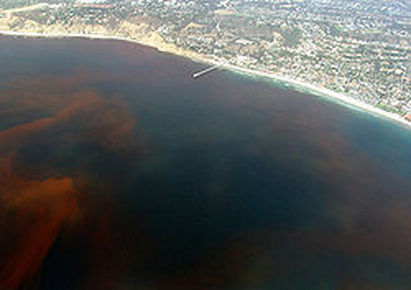What is Hypoxia?

Hypoxia taking place at the coast of New York.
Hypoxia is a phenomenon that occurs in aquatic environments in which dissolved oxygen becomes reduced in concentration to a point where it becomes life threatening to aquatic organisms living in the system , leading to the production of low-oxygen areas called dead zones. These regions are called so because life is not able to survive in these regions.
A healthy aquatic environment's oxygen saturation is always more than 80%. If this saturation reaches less than 30%, the organisms in the system will not be able to tolerate the low oxygen conditions and will die.
A healthy aquatic environment's oxygen saturation is always more than 80%. If this saturation reaches less than 30%, the organisms in the system will not be able to tolerate the low oxygen conditions and will die.
Dead Zones

Red circles show the location and size of many dead zones.
Black dots show dead zones of unknown size.
Dead zones are hypoxic (low-oxygen) areas in the world's oceans, the observed incidences of which have been increasing since oceanographers began noting them in the 1970s. These occur near inhabited coastlines, where aquatic life is most concentrated. (The vast middle portions of the oceans which naturally have little life are not considered "dead zones".) The term can also be applied to the identical phenomenon in large lakes.
In March 2004, when the recently established UN Environment Programme published its first Global Environment Outlook Year Book (GEO Year Book 2003) it reported 146 dead zones in the world's oceans where marine life could not be supported due to depleted oxygen levels. Some of these were as small as a square kilometre (0.4 mi²), but the largest dead zone covered 70,000 square kilometres (27,000 mi²). A 2008 study counted 405 dead zones worldwide.
In March 2004, when the recently established UN Environment Programme published its first Global Environment Outlook Year Book (GEO Year Book 2003) it reported 146 dead zones in the world's oceans where marine life could not be supported due to depleted oxygen levels. Some of these were as small as a square kilometre (0.4 mi²), but the largest dead zone covered 70,000 square kilometres (27,000 mi²). A 2008 study counted 405 dead zones worldwide.
Go to: Causes
